|
|
FARM 13 / STICK MARSH FISHING REPORTS
DECEMBER 2004
December 31, 2004
Bart Facwett called and said his son, Brad, was going to be down for the holidays. Bart wanted to make a fishing trip a Christmas present to Brad, plus to get him thawed out a bit. Brad is from Toledo, OH, and that’s a cold puppy this time of year!!!
These two guys were a real pleasure to fish with. I don’t think the bass were too happy with them, but I really enjoyed our time on the water. And, Brad finished out 2004 with a real fishing bang!!
We took a load of shiners and headed to Farm 13, with hopes of finding moving water. The east side pump was not running at all. But, the SE spillway had a slight water flow.
We found an eddy and moved against a shoreline well down from the gate. The shiner rods were rigged with a #3/0 hook directly to the FIRELINE. I usually hook shiners through the bottom lip and a nostril hole when bobber fishing. But, for free lining, it is best to hook the shiner just behind the dorsal fin. They will swim away from you and down when hooked that way.
The shiners did their job and Bart got his wish – Brad was in motion setting hooks and battling big bass so much that he thawed very quickly. Bart caught his share of fish, but this day belonged to Brad. He got one real giant bass and a number of others that were in the true ‘big bass’ category. The pictures of his best two fish speak for themselves.
I wish every fishing day were as enjoyable as this one was.
December 29, 2004
Kathleen Lawson and her brother, Jamie, wanted some crappie. I figured we’d go to Kennansville and get ‘em. We’d had a decent catch there two days earlier with Jim and Barry Keller, so I was enthused we could even improve on the Keller’s catch.
That’s what I get for thinking.
This crappie trip was ruff, spelled R-U-F-F. The weather was great, the water was fine, and the conditions had not changed a bit from the day the Kellers and I were there. But, the fish sure were not present in the grass edges we worked. Counting the throwbacks and those lost, I am not sure we even saw more than 15 crappie. We did manage enough for a good meal, but it was not anything like Kennansville Lake usually produces.
The crappie are, of course, still there. We just did not fish where they were, obviously. The same two people who were in the canal near the boat ramp when we were with the Keller’s were there again. I wonder if that should tell me something. We’ll let you know in a future report.
December 27, 2004
A soon as we wrapped up the Christmas festivities, the Father and son team of Jim and Barry Keller joined me on a trip after Kennansville crappie. It was a good trip, but not a ‘great’ trip.
The crappie were, in fact, right where we had expected them to be – right in the grass. No doubt, they were on the verge of spawning, as their bellies looked like they had swallowed a walnut. But, we made a few side excursions before going to the grass to fish.
We started out looking for schooled open-water crappie on a structure feature in the east canal. We hoped to do jigs on the ultralight rods and we also decided to set out a couple of minnow poles, as well. We worked this location for 20 minutes without even a bite. Actually, that was a good sign, in that is sort of confirmed that they were probably in the grass, rather than in the open water.
The south and north canals fared no better for open water fish, either. However, we did see two dedicated souls working the north canal near the ramp and they never moved all day. It is very possible they had something working.
We selected a canal that ran in the direction of the wind, thus allowing me to hold the boat parallel to the grass lines with the trolling motor. This kept both anglers in close enough o fish. Moving to the edges of the grass, we set up the 10-foot fiberglass poles with eight feet of light mono, a #2 gold wire hook, a split shot, and a small one-inch (diameter) foam bobber. We set the bobbers 18 inches above the hook, where we impaled small minnows through the tail.
TODAY’S PERCH JERKIN’ FISHING LESSON: In this type of live bait presentation, we are swinging the bait into pockets and holes in the grass. So, it is important that we have good control in order to place the minnow on target, while not getting hung up. To do this properly, always use the heaviest split shot that will still allow the bobber to float. That weight is like a pendulum and its mass equates into your ‘feel’ of the rig and ability to control it properly. If it is windy and you are still having control problems, move to a larger bobber and a correspondingly larger weight. The fish really don’t care much about the rigging – just the minnow!!
The water at the outer edge of the grass was about 2.5-3 feet deep, becoming a bit shallower in the pockets closer to the bank. We eased along 50 feet without any action. Then, there they were and the bobbers began to dip. We worked approximately 100 yards of this grass line, finding the fish a bit scattered along it. I watched the shoreline, both in front of and behind us, making mental note of certain features that would give us reference to fish locations. The first one was a lone small cypress tree behind us, directly across from a section that gave up six quick slabs. Another was a clump of reeds on a stretch that seemed to have a small concentration of fish. When we stopped getting bites or catching fish, we would go back to the reference points and fish those areas again.
Our fishing worked for a couple of dozen nice crappie and a number of throw-backs that we hoped would grow up to be the next World’s Record.
December 27, 2004
Like most everyone else, we took our Christmas break this past week. It was sure a good time to do it, too. Cold fronts, high winds and all the trimmings of winter came to visit central Florida. It is unusual for it to get this cold (38-44 degrees) this far down the peninsula, especially this early. We even had to delay three days of fishing trips until a time when the weather makes it more fun and not a punishment.
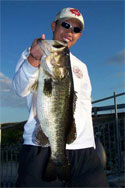 But, before the break, we had the opportunity to take out our old friend, Irwin Chu, his daughter Christine, and her friend Chris. What a great time we had, too. Irwin’s Prime Directive was that the two kids catch bass. Of course, he managed to get into the act, too!
But, before the break, we had the opportunity to take out our old friend, Irwin Chu, his daughter Christine, and her friend Chris. What a great time we had, too. Irwin’s Prime Directive was that the two kids catch bass. Of course, he managed to get into the act, too!
In the Christine and Chris did not fish much, our plan was to fish mostly wild shiners. But, we decided to make a couple of stops on shellbeds first, just to see if we could stir up a school of Stick Marsh bass. The first location quickly gave up a nice fish to a Texas-rigged, Green Pumpkin RIPPIN’ STICK. We continued to work the general location for another 15 minutes, but there were no more takers present.
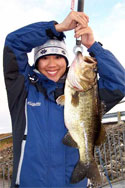 So, we zipped over to another section of submerged levee that had a huge shellbed on it. No takers there, either.
So, we zipped over to another section of submerged levee that had a huge shellbed on it. No takers there, either.
Over on the east side of Farm 13, we next addressed a thin line of mostly submerged grass along a canal edge. I had done pretty well there on a couple of recent trips. But, this time, it was just more wasted time.
Suddenly, the winds went from zero to 20 MPH in the blink of an eye. That told us it was time to go let those shiners do their thing.
Setting up on a grass line, we noted Hugh Crumpler and a party of two fishing some slowly moving spillway water. Hugh had gotten his boat positioned just right and was catching fish, even though no one had been able to the day before. I set the shiners out and we had a few bass and a pickerel, or two, suck them up pretty quickly. But, the bass were not there in numbers, so we moved to another nearby location.
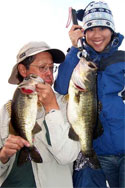 Positioning the boat just right is the whole key to catching bass at the location we were setting up on, especially since the water from the spillway was barely flowing. The shiners swam for 5 minutes, or so, and then the first one went down. Then, another bass took one of our hapless baitfish. It appeared we were starting to get them working well, when Crumpler and his crew starting pulling up their anchors. Irwin said he wanted to move to Hugh’s spot, so I agreed. As Hugh came by, he gave us a tip for catching those bass in that slow water.
Positioning the boat just right is the whole key to catching bass at the location we were setting up on, especially since the water from the spillway was barely flowing. The shiners swam for 5 minutes, or so, and then the first one went down. Then, another bass took one of our hapless baitfish. It appeared we were starting to get them working well, when Crumpler and his crew starting pulling up their anchors. Irwin said he wanted to move to Hugh’s spot, so I agreed. As Hugh came by, he gave us a tip for catching those bass in that slow water.
Thanks, Hugh. The tip worked like a champ. In fact, we refined it even more and caught bass in a steady procession.
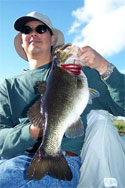 Christine and Chris only required minimal instruction on how to use the shiners and set the hook. From then on, it was ‘Katie, bar the door’, as the man once said. In fact, after two bass, Christine was doing it like a pro and missed virtually none. The average fish was about 3 lbs., with a great number being in the 4 and 5 lb. range.
Christine and Chris only required minimal instruction on how to use the shiners and set the hook. From then on, it was ‘Katie, bar the door’, as the man once said. In fact, after two bass, Christine was doing it like a pro and missed virtually none. The average fish was about 3 lbs., with a great number being in the 4 and 5 lb. range.
Irwin watched the kids for a while and then got into the act, himself. He caught bass, one after the other. But, his were all the smaller sizes, while Christine and Chris were walloping the larger bass. When Irwin and Christine had a double, Christine again had the larger fish, by far. They, then, hammed it up for a ‘poor old Dad’ picture. But, Irwin finally got into the act with those larger Stick Marsh bass and caught his share!
It only took about 2-1/2 hours to go through the six dozen shiners we had left. The fishing was fast and furious, with everyone having a fish in the 6 lb. (+) range. Christen had a number of those larger bass and, of course, the largest of the day. It was sure Ladies Day at the Marsh!!
December 19, 2004
Things are changing in the Stick Marsh. The absence of grass, coupled with some really cold weather, has changed a LOT of ways that people always caught bass and crappie in the past. There has been a lot of crying and teeth knashing at the ramp about how poor the fishing has become. I field questions almost every day that I am out there. Heck, I’m even having trouble finding them some days, and I am the luckiest angler I know!
Let me repeat what I have said a bunch of times since the hurricanes destroyed the grass:
The fish are still there. With no grass to hide in, the baitfish have been forced to school up like saltwater baitfish do – huge schools that are constantly on the move. The bass are following these schools of baitfish and, for a while, they were running them to the top for some great surface feeding action. It was not to hard to find the bass, IF you kept a good lookout for the surface activity. But, nearly all the surface feeding has stopped now. So, you have to get on your horse and find the fish each day.
The baitfish schools are apparently huge and spread over some large areas. I am assuming this because the bass schools are the same – huge and each is spread across a large area. This logically means there are fewer small schools of both. So, you really have to hunt for them. But, when you do find one, it is a 50-100 fish honeyhole. That honeyhole, unfortunately, will probably be good for only that day, as the baitfish are constantly on the move and trying to get away.
While I would have thought some of these schools would be in the wood on the south end of Farm 13, it appears the majority are on the canals, levees and the few submerged roadbeds in the northern half of the Farm. On any given day, they may be anywhere and that makes for a real ‘run-and-gun’ requirement. I have been lucky at finding bass on all but two days, so far. Some days, I only found small schools or a few singles/doubles on known shellbed location. Other times, it was that ‘mother lode’ school.
The only dependable way to catch bass is the moving water trick at one of the spillways. That is a ‘no skill required’ activity, but it will catch bass for most. The problem is that only 3-4 boats can really participate. Another problem starting to become very common is that those spillways are not going to be running much because we are now into the dry season in Florida.
I am the guy who has always told you that, if you are already a proficient bass angler, you do NOT really need a guide to effectively fish the Stick Marsh. I am changing that now. If you intend to spend time and money to travel any distance to fish the place, you really should get at least a half day with someone who can get you started. This fishing now is tough, even if you fish the place nearly every day, as I do.
December 17, 2004
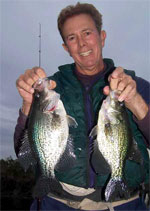 Richard Cowen and I had put off his trip to Kennansville once due to winds and cold. But, this day was a nice one sandwiched in-between cold fronts. We had conferred on the phone the night before and decided we’d better get to fishing before the weatherman changed his mind. Richard Cowen and I had put off his trip to Kennansville once due to winds and cold. But, this day was a nice one sandwiched in-between cold fronts. We had conferred on the phone the night before and decided we’d better get to fishing before the weatherman changed his mind.
In a previous report, I indicated that the Kennansville crappie, particularly the larger ones, appear to be ready to spawn NOW! That is nearly 60 days early from their usual habits. The eggs sacs are nearly bursting. What Richard and I found seemed to reinforce that.
First off, this was a very poor fishing trip. We stumbled around for a long time, catching only very small crappie. I anchored on a favorite place that has always produced fish and I recall Richard immediately got a 6-incher on a minnow. That was it, too. Nothing bothered the minnows further. This had actually been a favorite jig hole in past. But, today, the PERFECT Jig got not one strike off this anchor hole.
So, we moved into the north canal. Three or four little fish went for the live bait. Nothing went for the jig and we tossed it at a lot of reeds and grass on that north side.
We moved into the little neck that connects the lake to Big M canal. There, Richard immediately got a good crappie right at the edge of the grass. I thought we had found them for sure. But, that was the only strike we had.
We moved to the east canal. Zilch, nothing, failure.
We moved to the south canal. Again, a couple of little crappie on minnows.
We went back to the anchor spot and tried again. Nothing. I was getting a bit frustrated by now.
We decided to go back to the neck to Big M canal. At least, we’d seen a good crappie there. We started in a dredge hole that has 15 feet of water. It is a small hole and you can cast all around its edges from the middle. Bang, we got three big crappie on the PERFECT Jig and they all came from nearly the same spot. We beat the water to a foamy forth for another 20 minutes, but that seemed to be all that were there.
We eased up 50 yards to one of the overflow pipes that lets the water out of the lake and into the St. Johns River basin. Two little ones came quickly. Then, I got a good one. We worked the spot, but again we had no further action.
Moving another 50 yards, we started to work grass lines on both side of the narrow strip of water. We managed a couple more good crappie, some small non-keepers and a few bluegill. That was it.
So, we finally ended up with 8-9 good crappie and one runt (but, he was eating sized). Not much for a place so full of big crappie. Richard and I discussed trying to come up with an excuse for not catching more (too hot, too cold, to windy, too stuill, wrong color jig, barometer rising/falling, moon phase, etc.). But, we finally gave up. Our only valid excuse was that we either did not find the fish properly, or they just would not feed.
Someday, I am going to get to talk to a fish. THEN, I’ll find out why they do what they do (or don’t do). Yep, some day ---.
December 16, 2004
Did a half day with Paul Bryant (no kin to the Alabama ‘Bear’). It was a bit cool and a bit of wind. But, the weather was passable.
This was a standard day on the Stick Marsh. We looked hard and fast for bass, found a few, and caught around 30. Not a one was over 3 lbs. And most were closer to 2 lbs. The best lure was the 4-inch Watermelon Seed RIPPIN’ STICK on a Carolina rig. Slow or fast – it didn’t matter. Just get it wet and make it move seemed to be the ticket for the day. We never caught more than 3 bass off any one spot, so we can basically say we never found a true school.
December 12, 2004
Glynn and Suzy Byrd are delightful people to fish with. They made a slow day very enjoyable. Plus, Suzy put a wuppin’ on us with her shiners!!
We only had a half-day trip scheduled, so we moved fast and tried to locate a school of bass quickly. That did not work out in the first hour, so we reverted to the primary plan – ‘Bring plenty of shiners and make sure Suzy catches bass.’
That she did, too.
A poor wind condition (meaning it was not blowing properly to push the shiners towards the grass) would not let us set the boat for an optimum presentation of the shiners. So, we managed to position the big Blazer with Suzy’s end right up in the grass line, where we could get her shiners in close. That put Glynn 20 feet out from the grass and we had to constantly try to re-set his shiners in close. But, we were working to the ‘primary plan’.
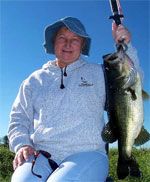 We had to sacrifice a few shiners to the pickerel and mudfish Gods. But, once they got thinned out (or, well fed), the bass finally got started. But, the bass seemed to be in close to the cover and wouldn’t move out a way to Glynn’s shiners.
We had to sacrifice a few shiners to the pickerel and mudfish Gods. But, once they got thinned out (or, well fed), the bass finally got started. But, the bass seemed to be in close to the cover and wouldn’t move out a way to Glynn’s shiners.
Suzy only needed to be told once how to take up line slack, feel for the bass and then set the hook. From then on, she was her own lady. Funny thing was that every bass she caught seemed to be bigger than the last one. She started small and finally got a really big old sow (see photo).
I think the lady liked that shiner stuff!
December 10, 2004
If you’ve been to the Stick Marsh, then you know that the bridge over Canal 54 (C-54) is where you turn off the paved road onto the Marsh ramp road. Everyone sees it and, if they have never launched a boat into it, wonders if the 'blah'-looking canal has any fishing prospects.
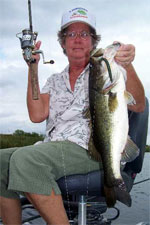 At the expense of letting proverbial ‘cat out of the bag’, let me just say that my wife caught 15 in C-54 yesterday, with a giant bass gal at the top of the list. Her five-fish tournament string would have weighed 18 lbs. Not bad for three hours fishing in a ‘ditch’, huh??
At the expense of letting proverbial ‘cat out of the bag’, let me just say that my wife caught 15 in C-54 yesterday, with a giant bass gal at the top of the list. Her five-fish tournament string would have weighed 18 lbs. Not bad for three hours fishing in a ‘ditch’, huh??
C-54 has little to no structure (bottom contour changes). On both sides, the water starts at about two feet deep at the edge of the vegetation, slowly tapers to five feet when it gets 10-12 feet from the bank, and then rolls downwards into nine (at the upper end) to 18 (at the lower spillway area) feet. That shape does not change for its entire length. There are a few small water inlet gates and culvert pipes along its length, bringing run-off waters in from the surrounding fields and wooded areas. It does have a LOT of cover, in that its entire length is bordered with reeds, grasses and some small willows on both sides.
In general, the few local anglers who ply C-54’s waters fishing along the vegetation for bluegill or drift the open water for crappie schools. There are a few caught, but the fish never seem to have what we’d call ‘favorite places’. Since the canal structure and cover features never change, the fish just don’t key to anything special. So, they usually have to be hunted each trip.
Except in the early winter period.
By Thanksgiving, the weather and waters will have cooled enough for the crappie to school up tightly in the open water. Drifting with live minnows is the quickest way to locate them. Sometimes they are found in the middle, but most often the schools seem to cruise within 20-30 feet of the shoreline. That places them adjacent to the sloping bottom from the shoreline to the deeper water. In general, the schools are always moving. But, they appear to move in circles, rather than straight along the canal, itself. Possibly, they have found baitfish in the grass along a portion of the shoreline and are just staying there, going in to feed when they like.
The bass, anticipating a mid-December through February spawning period, start to prowl for prospective spawning locations. They can now be found up in 2-5 feet of water, especially in stretches where the shoreline vegetation in thin or non-existent. The cyclic growth and decay of the vegetation tends to make an area very mucky. Bass need a clean, hard area to spawn. C-54 shoreline areas that have thin or no vegetation mean there is a limestone or coquina stone bottom. ‘Nuff said.
Our little foray to C-54 was to give Dot a chance to drive the new Blazer 202 PRO-V boat, as well as get on the water before a cold front passed through. We used a few minnows and the PERFECT Crappie Jig to corral enough crappie for a good fry and then went looking for the bass.
Dot likes the Carolina-rigged worm setup. So, we rigged one with the Green Pumpkin RIPPIN’ STICK in the 4-inch size.
Nearly every stretch of shoreline that had no vegetation produced fish. There were a LOT of small 10-12 inch bass caught; so many, in fact, that they actually became more pests than sport. But, a sudden influx of hoards of small bass into an area is usually a sure sign that the pre-spawn period has arrived.
All the bass caught appeared very healthy, with no body sores and certainly no marks of having been hooked in the past. They were not bulging with eggs, which would indicate a late spawn, possibly late January. But, most egg sacs were developed sufficiently to be able to feel them and visually see their division on either side of the belly.
We put them all back ‘to do their thing’, with hopes of maybe catching one of them someday when it weighs 25 lbs.!!!
December 9, 2004
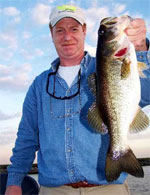 Our old friend, Robin Hood, was making his annual holiday visit to relatives in Cocoa when he decided it was time to fish. Robin owns the Rippler Lure Company and makes the famous Rippler spinnerbaits, buzzbaits and bass jigs. But, this is not the time for those lures on the Stick Marsh. So, we Rat-L-Trapped ‘em and Carolina RIPPIN’ STICKed ‘em.
Our old friend, Robin Hood, was making his annual holiday visit to relatives in Cocoa when he decided it was time to fish. Robin owns the Rippler Lure Company and makes the famous Rippler spinnerbaits, buzzbaits and bass jigs. But, this is not the time for those lures on the Stick Marsh. So, we Rat-L-Trapped ‘em and Carolina RIPPIN’ STICKed ‘em.
The afternoon started rather slowly, with only a few fish to show for running and gunning shellbeds and submerged levees. So, we decided to take our reserve of two dozen shiners fishing. For the first time in so long I cannot remember, the shiners just did not work out well. Robin caught a few bass on them. But, the vast majority got sucked up by big mudfish and other bait stealers we could not identify. Whatever they were, the shiner robbers picked us clean.
So, we headed back out to work on finding bass once more.
There was one really good place that had been producing lots of fish lately. But, when Robin and I had hit it earlier, there was only one lone sentinel bass guarding the fort. We decided to take another quick shot at the place and it was lucky we did.
Apparently, the advanced party of the bass school had arrived on this rather broad expanse of submerged levee. They were not a lot of fish and they were not exceptionally competitive/active. But, we moved round and round, from one section of the levee to the other and back again while Robin cranked a Rat-L-Trap. Every few minutes, Robin would grunt and set the hook on a nice ‘chunk’. Tossing the Carolina-rigged RIPPIN’ STICK (4-inch, Watermelon seed) out to the opposite side of the boat and away from Robin, I was able to draw strikes, too. So, it did not appear to matter which lure you used. But, Robin’s choice of the faster crank plug was best because he could make more casts and cover more water rapidly. And, he finally snagged onto a good bass, or two, as well!!
By the time the sun was disappearing, Robin had managed a respectable quantity of bass.
December 8, 2004
Ed Eble sure wanted to fish the Stick Marsh. So much so that he drove all the way from way across the state by himself to share our boat. I don’t think he was disappointed, either.
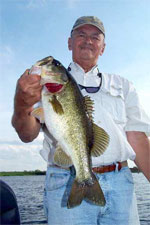 Ed is basically a saltwater guy. He chases redfish, trout and snook, with an occasional trip offshore. He knows how to fish, too. But, he didn’t know what a Carolina-rig was. That was what we needed to fish this trip, so we rigged the 4-inch RIPPIN’ STICK up on one and gave a demonstration. Ed is basically a saltwater guy. He chases redfish, trout and snook, with an occasional trip offshore. He knows how to fish, too. But, he didn’t know what a Carolina-rig was. That was what we needed to fish this trip, so we rigged the 4-inch RIPPIN’ STICK up on one and gave a demonstration.
We started slowly, with a fish here and two there. Then, later, we found a location with a good number of school bass dispersed all over a large shellbed. It was here that Ed got the hang of the C-rig. It sure is easier to learn the feel of the bottom versus the feel of a fish if you are getting strikes pretty regular.
Once Ed has his timing down, he missed virtually none of the strikes on the C-rig. But, the one he did miss was probably the one he really wanted!! The fish pulled gently on the RIPPIN’ STICK, making the tip of the rod dance. Ed drew down and made a solid hookset. Then, the bass made an even stronger ‘angler set’, pulled Ed out of his seat, and doubled the rod over to the surface of the water. As fate works, the hook then popped free. We just looked at each other.
We carried a few reserve shiners and did not want to let them go to waste. It was hard to stop the artificial presentations, since we were on some fish. But, the shiners offered a good chance to relax.
Sort of.
Danged bass ate the shiners pretty good. We started out with two rods in the water, but had to cut back to one at times. The strikes on the hapless shiners just came too fast and furious.
Ed caught a lot of fish and a few good ones, making his trip to the Stick Marsh just what he wanted it to be.
December 4, 2004
Mike Cubertson and Richard Sheppard drove at the way from Savannah, GA, to fish with us yesterday. That’s 314 miles, or 5 hours, any way you cut it. I have made the drive many times and know that Interstate 95 is really NOT a fun drive. They really wanted to fish the Stick marsh, after having heard so much about it.
As much as I have to admit it, The impoundment and I did not live up to their expectations.
Once in awhile, you can have a ‘hard’ trip on the Stick Marsh. That is usually due to winds, or some other impediment that has little to do with the actual fish, but affects the ability of the anglers to effective present lures. This day, the only problem we had was that we could not get on our prime shiner hole due to a crappie fishermen being too near it. Other than that minor item, we simply could not find a concentration of fish. Piecing together the events of the day, I figure we saw 19 fish and maybe boated 14. While that’s not all that bad in some waters, it was pretty poor for 9 hours on the best fishing hole I know of.
The first thing we did was sample three shellbed locations on submerged levees. I think I caught one good fish on a Rebel Deep Wee R while we were looking to see if the school was home. And, that was it. Towards the end of the day, we returned to the first shellbed and Mike took two on a Rat-L-Trap. But, the schools were not to be found.
From that start, we ran probably a half-mile of canal on the north end of Farm 13. We got nothing but mud on the lips of our crank plugs.
Then, we went south on two of the Farm’s canals. A few hundred yards of the first yielded nothing. On the second canal, we went all the way to the south end and the stump fields. Here, I think we hooked into 4 or 5.
Soon, being a bit weary of cranking those plugs so hard for so long, we took our meager shiner supply and went to some grasslines. Our old submerged barge had a crappie fisherman sitting on it. So, rather than disturb him, we opted to try some grass on the opposite shore. That didn’t work, so we moved around a bit, sampling different grass areas along the shore. The next three moves produced maybe four total fish. It could have been a couple of more, but I don’t recall. We did watch one boat, with a Father and his two young daughters in it, float shiners and catch some nice fish right out in the open water. It certainly was the right place for them, but it turned out to be the only place, too. It’s pretty bad when you have trouble catching with shiners.
Moving back out into the Farm, we returned to a shellbed and, as mentioned earlier, Mike nailed a couple. Then, suddenly, the weather went to pop. The wind came up from clam to 25 MPH and the air temperature dropped a good 10 degrees. Looking for a windbreak for our last hour of fishing, we headed over to the east side of the Farm.
It was on that east side that I suddenly recalled a long strip of submerged grass that the hurricane had not destroyed. It was not much grass, as we usually know it. But, it was green and was underwater. And, it DID have bass on it!!
This turned out to be the best action of the day. We initially put all the lures in the water, mine included, to see if we could draw a strike. I recommended spinnerbaits or Rat-L-Traps to Mike and Richard, while I went with my RIPPIN’ STICK. My second cast produced a strong, big fish. I got one heart-stopping surge out of her before the hook apparently just came out. But, it was a good sign, for sure!!
As it turned out, Mike’s Rat-L-Trap was the key lure, while Richard’s spinnerbait did not draw a strike. Mike landed 5 or 6 in rapid succession, with 3-4 coming off on the initial jump. A couple of those who threw the lure were really nice bass and hit very close to the boat. I suppose they just nipped at the lure at the last moment and were never really hooked well. If we had been fortunate enough to have fished this grass line earlier, I suspect we would have had a great day and one or two big bass.
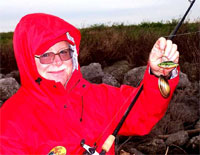 In one good moment of levity, Richard fought a mighty Stick Marsh mussel to a standstill on a Rat-L-Trap. It was a tough fight, but the angler ‘won’. It was duly noted that ‘you have to fish deep and slow to catch mussels on a crank plug!’
In one good moment of levity, Richard fought a mighty Stick Marsh mussel to a standstill on a Rat-L-Trap. It was a tough fight, but the angler ‘won’. It was duly noted that ‘you have to fish deep and slow to catch mussels on a crank plug!’
But, that’s fishing. Sometimes you is the bug and sometimes you is the windshield.
December 1, 2004
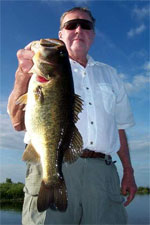 I had the pleasure of hosting Wally LaFary and Bob Richter this day. Both are from Cincinnati, OH, and were down to visit relatives and fish a bit. The temperatures in the Cincinnati, I was advised, was somewhere between ‘cold’ and ‘dang cold’. These two guys have been fishing together for a long time, so I knew we would have a good time. I had the pleasure of hosting Wally LaFary and Bob Richter this day. Both are from Cincinnati, OH, and were down to visit relatives and fish a bit. The temperatures in the Cincinnati, I was advised, was somewhere between ‘cold’ and ‘dang cold’. These two guys have been fishing together for a long time, so I knew we would have a good time.
Walt sent me some pictures of his recent excursion to Brazil for giant Peacock Bass. They are awesome, to say the least. One of the Peacocks was within a pound of the existing World’s Record. I will try and run a few of those for you at a later date. Sure makes me want to go south and fish!!!
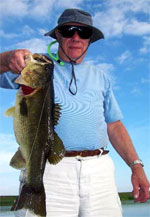 Outside of a decent number of bass that came on artificials, it was again the shiner supply that made our trip such a success.
Outside of a decent number of bass that came on artificials, it was again the shiner supply that made our trip such a success.
We set the shiners out on a ‘special’ grass line, one of few remaining in Farm 13, and the bass did the rest. I am not sure how many bass were caught, as I got so involved in netting and baiting hooks that I failed to count well. But, it was a great time. The shiners really got a workout, as the bass seemed to want to toy with them for a moment before blasting them to the surface. We had good ringside seats to the bass running the shiners up onto the surface and then swirling on them. Sometimes, it took them 3-4 passes before they took the shiners and sounded. The poor shiners were looking for a ladder to climb to get away from the hungry bass, but there just wasn’t one available.
It was kinda hard to determine just who finally wound up with the largest bass. I think Wally won out. But, as the pictures show, it sure was close.
November 29, 2004
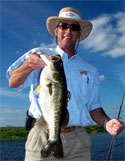 I avoided asking Andy Griffiths the inevitable question for a few hours. But, finally, I broke down and asked him how often he was asked about where Opie was. He laughed and said ‘a lot’.
I avoided asking Andy Griffiths the inevitable question for a few hours. But, finally, I broke down and asked him how often he was asked about where Opie was. He laughed and said ‘a lot’.
After having heard so much about the place, Andy and Bill Smith came to fish the Stick Marsh with us. Bill, from nearby Vero Beach, is a relative of Andy’s, while Andy is out of Key West, FL. In fact, Andy runs a fleet of deep sea charter boats (see his web site at www.fishandy.com).
With just a half-day to work with, we all agreed to do a little with artificials and then go to shiners. We worked the submerged levees and canals, and then we ran shellbeds. A few fish came around to the boat. One small school was located and that made for some fast, but brief, action.
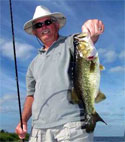 Taking the Blazer down to the south end of Farm 13, we eased around with the depthfinder and finally located an east/west ditch that runs most of the way across the impoundment. This ditch is not on any maps, but shows up on the old Indian River County tax office aerial photos. It can also be located by a grass line that grows on its single small levee on its south side. This grass line is very faint and nearly invisible at most times, but can be seen well when the water is low. Of course, with the recent disappearance of all the grass in the impoundment, you really have to look hard for it. (Super Secret Hint of the Week: the western part of this ditch runs right across the north end of the ‘Nursery’.)
Taking the Blazer down to the south end of Farm 13, we eased around with the depthfinder and finally located an east/west ditch that runs most of the way across the impoundment. This ditch is not on any maps, but shows up on the old Indian River County tax office aerial photos. It can also be located by a grass line that grows on its single small levee on its south side. This grass line is very faint and nearly invisible at most times, but can be seen well when the water is low. Of course, with the recent disappearance of all the grass in the impoundment, you really have to look hard for it. (Super Secret Hint of the Week: the western part of this ditch runs right across the north end of the ‘Nursery’.)
Only one bass came from this ditch location, but it weighed about 5.5 pounds. I suppose that was worth the 20-minute stop. But, we needed some quantities, too. So, we pointed the big boat towards a bit of grass remaining along the eastern shoreline and its paralleling canal.
Setting the shiners out, the action was quick in coming. Our only problem was that we just wished we’d brought more shiners!! The bass stalked and grabbed the shiners on a regular basis, with some running the shiner to the top and blowing the poor baitfish up into the air. Good, quality bass were caught by all.
And, that’s what it’s all about!
November 27, 2004
Happ Harrison and his lovely wife, Deb, came to fish the Stick Marsh with us. The ‘Prime Directive’ was that Deb has a good time.
MISSION ACCOMPLISHED!!
Plus, Happ and I had a good time, too!
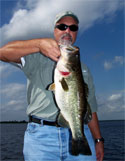 With the artificial bite a bit slow (also called ‘the guide could not find a big concentration of fish’), we decided to go with our wild shiners. We had basically devised a strategy of ½-time artificials and ½-time shiners going in, so we were all prepared for the contingency.
With the artificial bite a bit slow (also called ‘the guide could not find a big concentration of fish’), we decided to go with our wild shiners. We had basically devised a strategy of ½-time artificials and ½-time shiners going in, so we were all prepared for the contingency.
Setting the 202 Pro-V Blazer up parallel tone of the few remaining grasslines in Farm 13, we floated the shiners under bobbers at about 24-inches of depth. I explained that either the action would start slam-bang right away (if the fish were along the edges of the grass) or we would gradually build from slow bite to a very rapid action as the bass gathered.
It is my experience that the fish have some way of detecting other bass feeding. Possibly, it is the sound of the splashing or some other sensing method. Whatever it is, I know that it works. If you are still fishing live bait in the general proximity of an area that is holding bass and you begin to catch some, it appears that the others seem to migrate towards where the action is. The only other explanation I have is that you may be fishing on a god movement route. Then, when a school comes by, they stop and feed on the continual supply of shiners that seem to be magically appearing in front of them. Since most shiner fishing is done on grass lines (disregard the special cases of moving water at spillways), the theory fits, it that grasslines and other ‘edges’ are always movement routes.
But, back to Happ and Deb.
Nearly all women anglers I have fished with, as well as 50% of the men, simply will not set a hook hard. Most times, the bass actually takes care of most of the hooking by refusing to let go of a lure or bait and trying to run with it. When he hits tension on the line, he is usually hooked sufficiently. But, if the single hook of a worm, jig, or shiner rig happens to have its point against a bone of the hard lip area of the bass, the only way to secure an adequate hook-up may be the sharp, firm hookset the angler provides. Nothing is more frustrating than having fish missed due to a ‘wimpy’ hookset. My instructions on hooksetting are usually something like – ‘try to break the rod, turn the boat over, and jerk the fish clean over the boat.’
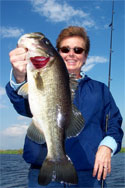 Deb Harrison was an exception to the above situation. At times I though she might actually ‘break the rod, turn the boat over, and jerk the fish clean over the boat’!! This lady was petite, pretty as she could be, and one heck of a fish-snatcher. I mean Deb put the ‘hurt’ on the fish if the got her shiner!
Deb Harrison was an exception to the above situation. At times I though she might actually ‘break the rod, turn the boat over, and jerk the fish clean over the boat’!! This lady was petite, pretty as she could be, and one heck of a fish-snatcher. I mean Deb put the ‘hurt’ on the fish if the got her shiner!
The next great thing was that she really liked this shiner fishing. I am not sure that she had ever done live bait for bass. If she had, it must have few times and not successful. Deb was so excited and intense it started to rub off on Happ and I, too. We were all whooping and hollering every time she hooked into another big Stick Marsh bass. I wish I had the web space for all her pictures, but I can only do her best fish. Numerous others were not far behind it in quality.
Of course, Happ was fishing in the same approximate location, so he was yanking bass, too. And, he did very well. When the shiners in the baitwell started to thin down, Happ insisted that Deb do the fishing with the rest. And, fish that lady did!
Happ and Deb Harrison are the type people who make guiding an enjoyable job.

Today's Weather for
the Stick Marsh Area
Past Stick Marsh Fishing Reports
Farm 13 / Stick Marsh Information Guide
Email questions to jporter@jimporter.org.
|
Recommended sites by The Fishin' Tipster |
A common question that we get: "Is there somewhere close to get bait and tackle?" This is where we get our bait.

Pete and Tina Heinz / 9 South Mulberry St. / Fellsmere, FL 32948 / 772-571-9855
Get your site listed here
Let us help you drive more targeted traffic to your site.
|


Rank our Site
©Copyright 2001-07 All rights reserved by Jim Porter, any reproduction, quotation or other use of this site or its elements is prohibited without the express written permission of Jim Porter
|
|


 FROGG TOGGS RAIN GEAR
FROGG TOGGS RAIN GEAR
THE BEST PRICES AVAILABLE!!


|
|







